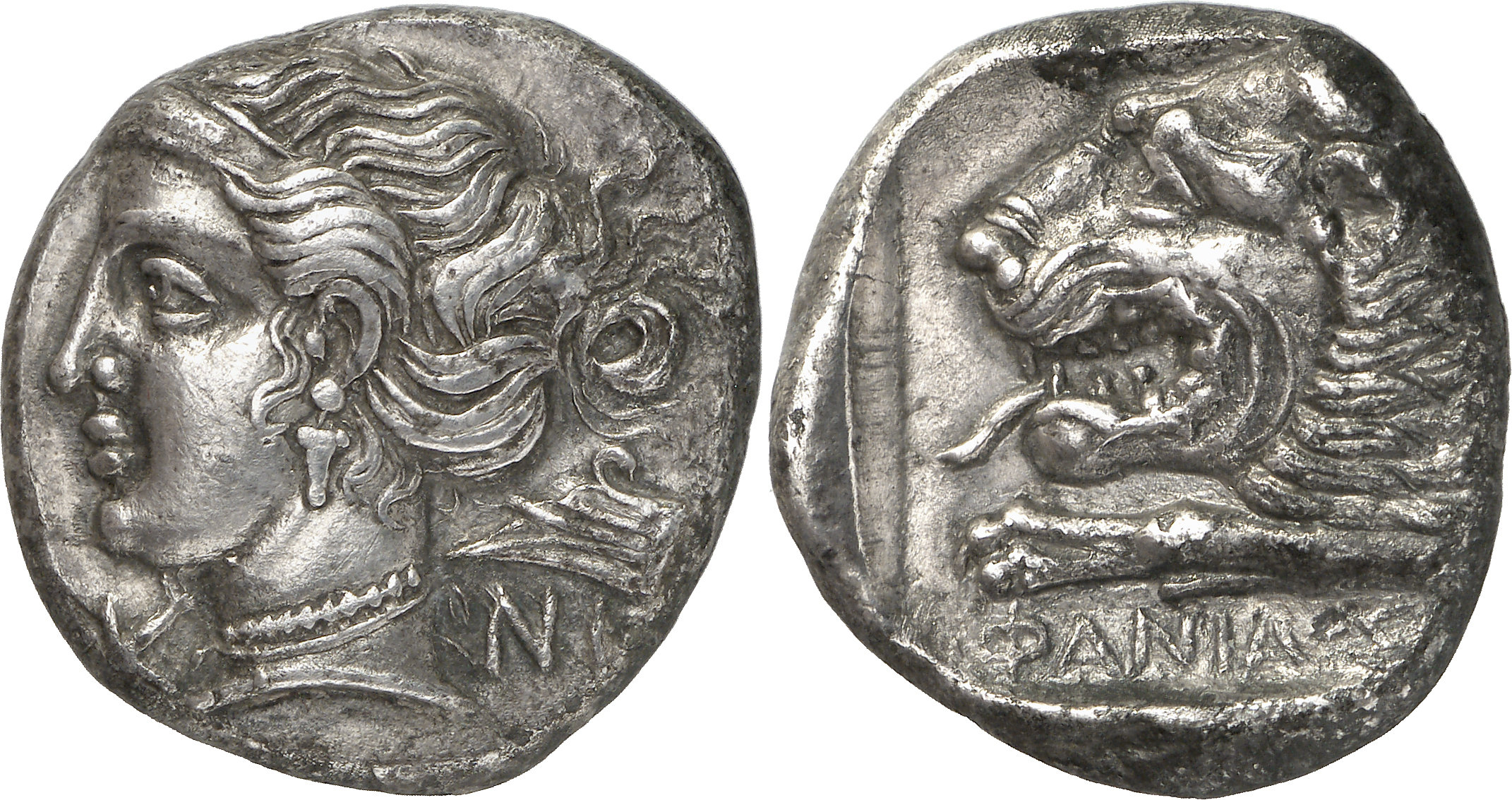Cnidus, silver, tetradrachms (395-380 BCE) Ashton
From SILVER
(Redirected from S 1957 - Cnidus, silver, tetradrachms (395-380 BCE) Ashton)
395 BCE - 380 BCE Silver 4,247 kg
Description
| ObverseInscription or printing placed on the obverse.: | K-NI (Greek).head of Aphrodite Euploia facing to left, her hair tied with a broad band, wearing an earring and a necklace, a prow behind |
| ReverseInscription or printing placed on the reverse.: | ΦANIAΣ (Greek).Forepart of a lion to left, its jaws open and tongue protruding |
Mint and issuing power
| MintIdentifies the place of manufacture or issue of a numismatic object.: | Cnidus | Ancient regionAncient region.: | Caria | Modern countryModern country: Turkey | AuthorityIdentifies the issuing power. The authority can be "pretended" when the name or the portrait of X is on the coin but he/she was not the issuing power. It can also be "uncertain" when there is no mention of X on the coin but he/she was the issuing power according to the historical sources: |
Chronology
| FromIdentifies the initial date in a range assigned in a numismatic context. | 395 BCE | toIdentifies the final date in a range assigned in a numismatic context.. | 380 BCE | PeriodTime period of the numismatic object.: Classical 480-323 BC |
Physical description
| MetalThe physical material (usually metal) from which an object is made.: | Silver |
Median weightMedian of the weights of numismatic objects (in grams). in grams | 14.90 | DenominationTerm indicating the value of a numismatic object. Examples: tetradrachm, chalkous, denarius.: | tetradrachm |
StandardStandard.: |
Image

S1957 Knidos tetradrachms Ashton.jpg [1]
References
| Die study referencePublication of the study: | Ashton - Kinns - Konuk - Meadows 20021Ashton - Kinns - Konuk - Meadows 2002, p. 116-119 | ||
| Coin series referenceReference to coin series study: | Sear II2Sear II, n° 4839 | ||
| Coin series web referenceCoin series web references: | |||
Obverse dies distribution
| FrequencyFrequency of specimen in distribution. ᵖ | Number of obversesNumber of obverse dies. ᵖ (o) | % (o) | Number of coinsNumber of coins. (n) | % (n) | Die nameName(s) of the die(s). |
| 1 | 2 | 15.38 | 2 | 2.86 | 1, 12 |
| 2 | 4 | 30.77 | 8 | 11.43 | 6, 8, 10, 11 |
| 4 | 1 | 7.69 | 4 | 5.71 | 5 |
| 5 | 2 | 15.38 | 10 | 14.29 | 2, 3 |
| 7 | 1 | 7.69 | 7 | 10 | 9 |
| 10 | 1 | 7.69 | 10 | 14.29 | 13 |
| 12 | 1 | 7.69 | 12 | 17.14 | 4 |
| 17 | 1 | 7.69 | 17 | 24.29 | 7 |
| Total | 13 of 13 | 99.98 | 70 of 70 | 100.01 |
Reverse dies distribution
no distribution is available
Quantification
| Number of obversesNumber of obverse dies. ᵖ (o) | 13 | Number of singletons (o1)The number of singleton coins. ᵖ | 2 |
| Number of reverse diesNumber of reverse dies. (r) | 32 | Number of coinsNumber of coins. (n) | 70 |
| Coins per obverse dieNumber of coins per obverse die. (n/o) | 5.38 | Coins per reverse dieNumber of coins per reverse die. (n/r) | 2.19 |
| Reverse per obverse ratioRatio of obverse dies divided by reverse dies. (r/o) | 2.46 | Percentage of singletons (o1)number of coins (n) divided by the number of singletons (o1) ᵖ | 15.38 % |
| Original number of dies (O) (Carter 1983 formula)The estimation of the number of coins according to Carter 1983 ᵖ | 14.25 | Coins struck if 20,000 as average productivity per dieCoins made if the average productivity for obverses (according to Carter) is 20,000. ᵖ | 285,000 |
| Original number of dies (O) (Esty 2011 formula)The estimation of the number of coins according to the singleton formula in Esty 2011 ᵖ (O) | 15.96 | Survival rate if 20,000 as average productivity per dieSurvival rate if average productivity is 20,000. ᵖ | 0.00025 |
| Coverage (o = % of O) (Esty 1984 formula)Esty 1984 - coverage (% of O) ᵖ (o = % of O) | 97.14% | Die productivity if survival rate 1/2,000Average productivity if survival rate is 1/2,000. ᵖ | 9,824.56 |
| Weight of silver (in kg) if 20,000 coins per die (O = Carter formula)Carter 1983 * Median weight * 20000 (*10 if gold or electrum) ᵖ | 4,247 kg <br /> 4,247 kg | Die productivity if survival rate 1/5,000Average productivity if survival rate is 1/5,000. ᵖ | 24,561.4 |
Remarks
Most likely one single workstation Likely military